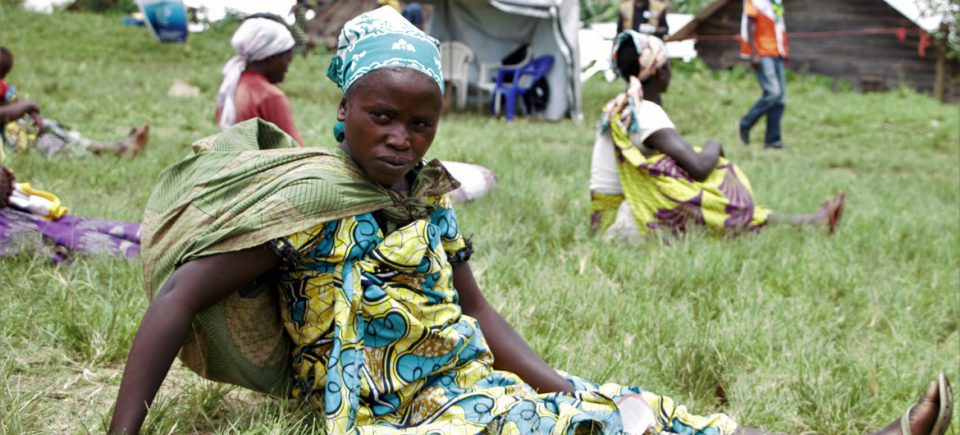As Lidia Ajuwa, 30, walks down the hill into Kibarizo, a remote village in eastern Democratic Republic of the Congo’s North Kivu province, she is greeted with smiles as she passes rows of small, grass-thatched houses. Hers is a familiar and friendly face in a region that for years has grappled with insecurity.
She has walked for hours along muddy roads impassable to vehicles to reach the home of Agizo*, a 38-year-old woman previously displaced by violence who was raped when armed men attacked the village a few nights previously.
“I don’t know where they came from. They killed my husband then five of them raped me. I stayed there screaming in pain, without anyone’s help,” she whispers.
Lidia listens intently, writing notes in her handbook. Once Agizo finishes recounting the harrowing details, Lidia refers her to a health center some 20 kilometres away for medical and psychological care and gives her money for transport.
“Every story has a human behind it…”
For Lidia, this is a typical day working as a protection monitor for INTERSOS – a partner of UNHCR, the UN Refugee Agency. Since she began in 2019, she has often been among the team of first responders to sexual violence and other human rights violations against people already displaced from their homes by this region’s long history of conflict.
A ‘state of siege’ enforced by Congolese authorities across North Kivu and Ituri provinces since May 2021 aimed to curb lawlessness and violence perpetrated by countless militia groups. However, the measure has provided only limited respite for local citizens amid continuing outbreaks of violence.
“I hear stories like Agizo’s every day,” Lidia says. “Every story has a human behind it, who goes through suffering that many of us could not imagine existed. Being a woman myself, I also feel scared because I know that this can happen to me too.”
She and 77 other protection monitors working across this vast region navigate tough terrain and frequent dangers to reach people in need, linking them to vital assistance provided by UNHCR and its partners including health care, legal justice, and psychosocial support
“Our work is complex, and our response is based on what is possible,” Lidia explains. “If there is a solution on the spot, we provide help right away, but we often work in remote areas, where we have to refer the victim to a place where they can get assistance such as medical care.”
With many of the areas where they work inaccessible even by motorbike, Lidia and her colleagues often walk for long distances, exposing them to the threat of violence or kidnap in areas controlled by various armed rebel groups.
“Sometimes, the violence stops us from reaching our destination,” she explains. “I have to watch my step, or I too can become a victim.”
Every week, hundreds of incidents against civilians are recorded in eastern DRC by people like Lidia. During 2021, UNHCR, through INTERSOS, recorded more than 65,000 separate human rights abuses in the east of the country alone. More than 5.6 million Congolese were internally displaced at the end of 2021, the majority in the four eastern provinces of North and South Kivu, Ituri and Tanganyika.
Obed*, 25, will never forget the day in 2020 when he was caught in the crossfire between two armed groups.
“We couldn’t escape the fighting, we were just lying on the floor as the bullets flew over us,” he recalls. “At some point, I noticed my foot had swollen and realized I had been shot.”
Lidia heard of the attack and made her way to Obed’s home once the fighting had stopped. Together with a colleague, they took Obed to a dispensary in the village but there was no medication, so they paid for a motorcycle to take him to the next town for treatment.
“Lidia and her colleague really helped me,” says Obed. “I can only thank them, because without their help I would have died.”
UNHCR leads the protection response for internally displaced people in DRC, coordinating joint efforts with other UN agencies partner organizations such as INTERSOS to assist those in need.
Alexis Baruti, UNHCR’s Protection Associate based in Goma highlights the crucial role that Lidia and other protection monitors in the region play.
“By responding to protection alerts, people like Lidia can link survivors to lifesaving services and improve the overall protection of human rights of the communities in the region,” he says.
Collecting information about human rights violations and other protection incidents in a systematic manner allows for the analysis of trends by region and sector, revealing some of the driving factors such as inter-ethnic tensions, impunity for perpetrators and abuse of power.
UNHCR also collects alerts from other partners in order to have comprehensive data on human rights violations in areas hosting IDPs.
“This way, we can advocate for appropriate action and responses among the humanitarian community,” Baruti adds.
In a region still beset by violence and insecurity, Lidia’s work is never truly done. But as she moves on to the next location, she is driven by the knowledge that for every person she helps she is making a difference.
“What I love about this work is that I can contribute to the struggle of my people and help make the law a reality for them.”


